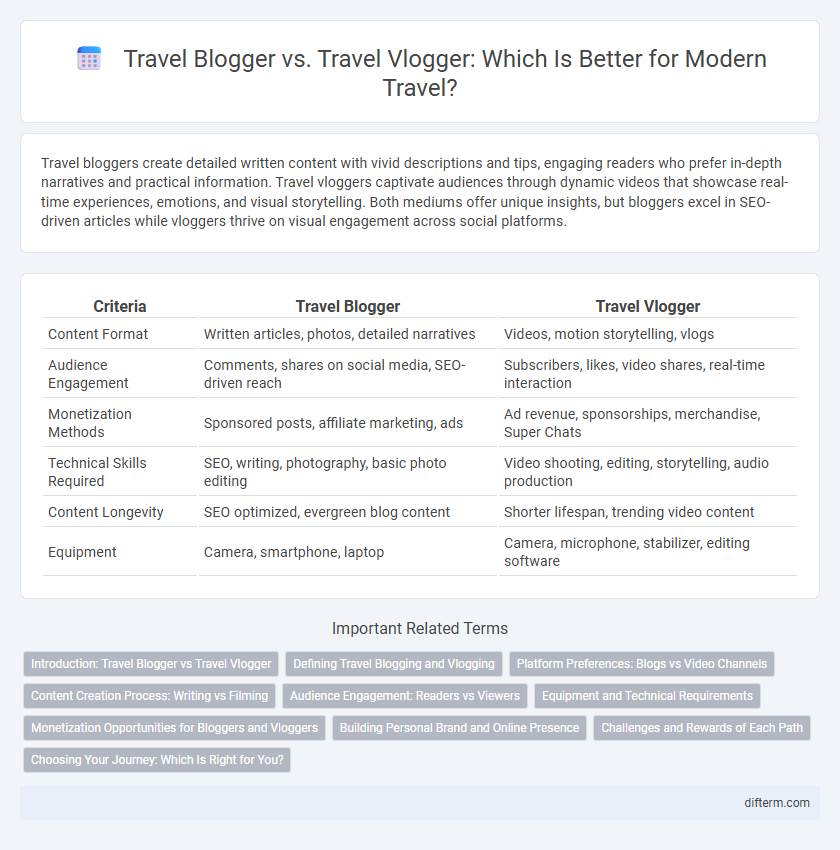Travel bloggers create detailed written content with vivid descriptions and tips, engaging readers who prefer in-depth narratives and practical information. Travel vloggers captivate audiences through dynamic videos that showcase real-time experiences, emotions, and visual storytelling. Both mediums offer unique insights, but bloggers excel in SEO-driven articles while vloggers thrive on visual engagement across social platforms.
Table of Comparison
| Criteria | Travel Blogger | Travel Vlogger |
|---|---|---|
| Content Format | Written articles, photos, detailed narratives | Videos, motion storytelling, vlogs |
| Audience Engagement | Comments, shares on social media, SEO-driven reach | Subscribers, likes, video shares, real-time interaction |
| Monetization Methods | Sponsored posts, affiliate marketing, ads | Ad revenue, sponsorships, merchandise, Super Chats |
| Technical Skills Required | SEO, writing, photography, basic photo editing | Video shooting, editing, storytelling, audio production |
| Content Longevity | SEO optimized, evergreen blog content | Shorter lifespan, trending video content |
| Equipment | Camera, smartphone, laptop | Camera, microphone, stabilizer, editing software |
Introduction: Travel Blogger vs Travel Vlogger
Travel bloggers create engaging written content that combines detailed narratives, tips, and destination reviews, optimizing their posts with keywords for search engine visibility. Travel vloggers produce dynamic video content showcasing immersive visuals and real-time experiences, leveraging platforms like YouTube and Instagram for broader audience reach. Both forms leverage storytelling and SEO strategies to attract and influence travel enthusiasts worldwide.
Defining Travel Blogging and Vlogging
Travel blogging involves creating detailed written content, often supplemented with photos, that narrates personal experiences, tips, and destination guides. Travel vlogging focuses on producing video content that provides a visually immersive storytelling experience, capturing real-time moments and dynamic interactions. Both mediums share the goal of inspiring and informing travelers but differ primarily in format and sensory engagement.
Platform Preferences: Blogs vs Video Channels
Travel bloggers often prefer platforms like WordPress or Medium to share detailed written narratives and high-resolution images that enhance SEO and reader engagement. Travel vloggers typically choose video channels such as YouTube or Vimeo, leveraging dynamic visuals and real-time storytelling to attract subscribers and increase watch time metrics. Both platforms optimize content delivery differently, with blogs excelling in keyword-driven discovery and video channels benefiting from algorithmic promotions based on viewer interaction.
Content Creation Process: Writing vs Filming
Travel bloggers excel in crafting detailed, SEO-rich narratives, weaving personal experiences and destination insights into engaging written content optimized for search engines. Travel vloggers focus on dynamic visual storytelling, utilizing high-quality video production techniques, cinematography, and real-time experiences to captivate audiences on platforms like YouTube and Instagram. Both forms demand unique skill sets: bloggers prioritize writing, keyword integration, and photo editing, while vloggers invest in filming, video editing, and sound design to enhance viewer engagement.
Audience Engagement: Readers vs Viewers
Travel bloggers engage readers through richly detailed narratives, immersive storytelling, and vivid imagery that appeal to the imagination and emotions. Travel vloggers capture viewer attention with dynamic visuals, real-time experiences, and interactive video content, fostering a more immediate and personal connection. Audience engagement in travel blogging relies on written expression and comments, while travel vlogging leverages visual appeal and live viewer interaction to build community.
Equipment and Technical Requirements
Travel bloggers primarily rely on high-quality cameras, laptops, and photo editing software to capture and enhance images for their written content, emphasizing strong writing and SEO skills. Travel vloggers require advanced video equipment such as 4K cameras, stabilizers, microphones, and editing software like Adobe Premiere Pro or Final Cut Pro to produce engaging visual narratives. Both need reliable portable chargers and durable storage solutions, but vloggers face higher technical demands for video production and editing workflows.
Monetization Opportunities for Bloggers and Vloggers
Travel bloggers primarily monetize through affiliate marketing, sponsored blog posts, and display ads, capitalizing on their written content and SEO strategies to attract consistent traffic. Travel vloggers generate income via YouTube ad revenue, brand partnerships, and merchandise sales, leveraging video engagement and subscriber growth for higher CPM rates. Both platforms offer unique monetization opportunities, with bloggers benefiting from long-form content monetization and vloggers excelling in visual storytelling and audience interaction.
Building Personal Brand and Online Presence
Travel bloggers cultivate a personal brand through detailed written narratives and SEO-optimized content that builds authority and trust over time. Travel vloggers leverage visual storytelling and dynamic video platforms like YouTube and TikTok to rapidly engage audiences and showcase real-time experiences. Combining impactful storytelling across both mediums enhances online presence, driving brand recognition and follower loyalty in the competitive travel industry.
Challenges and Rewards of Each Path
Travel bloggers face the challenge of crafting engaging written content that captures sensory experiences and cultural nuances, requiring strong storytelling and SEO skills to attract and retain readers. Travel vloggers encounter technical hurdles such as video editing, equipment management, and maintaining viewer engagement through dynamic visuals and authentic narration. Both paths offer the reward of building a dedicated audience and influencing travel trends, with bloggers excelling in in-depth narrative and vlogs providing immersive visual experiences.
Choosing Your Journey: Which Is Right for You?
Travel bloggers offer detailed written insights and vivid storytelling that capture the essence of destinations through words and photography, making them ideal for readers who prefer immersive narratives and in-depth guides. Travel vloggers provide dynamic video content that showcases real-time experiences, allowing viewers to see sights, sounds, and emotions firsthand, perfect for those seeking visual inspiration and authentic travel moments. Choosing between a travel blogger and a travel vlogger depends on your preferred media consumption style and whether you value comprehensive written information or engaging audiovisual storytelling.
Travel blogger vs Travel vlogger Infographic

 difterm.com
difterm.com